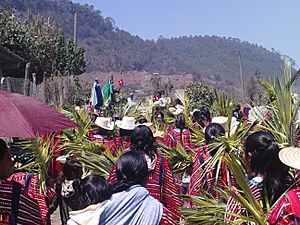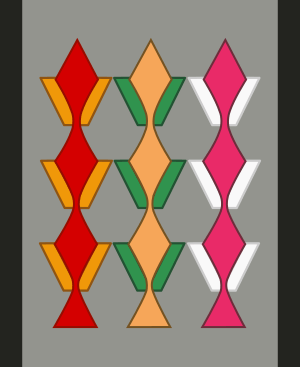Triqui facts for kids

Trique people during a Palm Sunday procession
|
|
| Total population | |
|---|---|
| 25,883 | |
| Regions with significant populations | |
| Languages | |
| Trique, Mixtec & Mexican Spanish | |
| Religion | |
| Catholic, Protestant & Native trique religion | |
| Related ethnic groups | |
| Mixtec people & Cuicatec people |
The Triqui or Trique people are an native group living in the western part of Oaxaca, a state in Mexico. They are mainly found in the areas around Juxtlahuaca, Tlaxiaco, and Putla. About 23,000 Trique people live there.
The Triqui language is part of the Mixtecan language family. It is related to other languages in the Oto-Manguean group. Trique people are well-known for their unique woven clothes called huipiles, as well as their baskets and morrales (handbags).
The Triqui homeland is a mountainous area called "La Mixteca Baja." It is located in the southwestern part of Oaxaca, Mexico. The land here is very high, ranging from about 1,500 to 3,000 meters (4,900 to 9,800 feet) above sea level. Because of this high elevation, low-lying clouds often cover entire towns in the afternoons and evenings.
Many Triqui men travel to bigger cities like Oaxaca City, Mexico City, or even the United States. They work as day labourers or migrant workers. This is because the average daily pay in rural Oaxaca is low, often less than $5 (U.S.). The La Mixteca region is also the poorest part of Oaxaca. Sending money back home helps their families in Oaxaca. Triqui women usually stay in their home region and do not travel as much as the men.
Triqui Traditions and Customs
One special custom of the Triqui people is called bride price. This was a common practice among native groups in Mesoamerica long ago. Other groups in Oaxaca, like the Mixtecs, still practice a similar tradition. In Trique culture, a man might offer money, food, or other goods to the bride's family. This is done to ask for her hand in marriage.
Usually, the man and woman already know each other before this arrangement. The marriage also requires the consent of both people. Some people do not agree with this custom, saying it might seem like slavery. However, those who support it say that consent is always needed. They also believe this Triqui custom is not wrong.
Farming and Crops
The Triqui people earn money by growing different crops. These include corn, beans, pumpkin, chili peppers, quelite (a type of green vegetable), and lima beans. The most important crops they grow are bananas and coffee beans.
These products are sold at open-air markets called tianguis. You can find these markets in towns like Chicahuaztla, Copala, San Martín, Itunyoso, Tlaxiaco, Putla, or Juxtlahuaca.
The Triquis use a farming method called slash and burn. This means they cut down and burn plants to clear land for planting. Many families (about 20-30 people) work together to plant milpa (corn fields) on large areas of land. This teamwork is known as «mipa colectiva» or «milpa en compañía».
Raising Animals
Another way Triqui families earn money is by raising animals. They mainly raise larger animals like cattle, bovines, sheep, goats, pigs, and horses. They also raise smaller animals such as chickens, turkeys, and ducks. In the lower parts of their land, some Triquis also practice beekeeping.
Popular Sports
The most popular sport among the Triqui people is basketball. You can find a basketball court in almost all their communities. Tournaments are held during local festivals, where many athletes join in. Schools also organize basketball tournaments for students from different schools. Football (soccer) is also becoming more popular, though it is not as widely played as basketball.
A documentary film called Gigantes Descalzos tells the story of a team of young Triqui basketball players.
See also
 In Spanish: Pueblo triqui para niños
In Spanish: Pueblo triqui para niños


